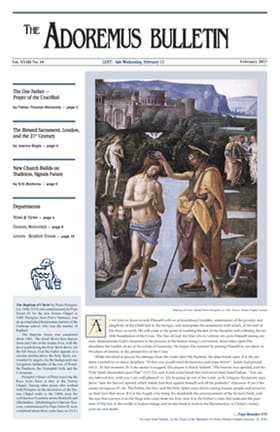Online Edition:
February 2013
Vol. XVIII, No. 10
Table of Contents

Baptism of Christ (detail) Pietro Perugino, ca 1482. Fresco, Sistine Chapel, Vatican
News and Views — Stroik: The Church Building as a Sacred Place | Pope Benedict’s Infancy Narratives | New Resource for World Youth Day 2013 | Liturgy Conference in Ireland on Vatican II
The Our Father — Prayer of the Crucified by Fr. Thomas Weinandy, OFM Cap.
The Blessed Sacrament, London, and the 21st Century, "Two Cathedrals" Procession Observes Beatification of Cardinal Newman, by Joanna Bogle
New Church Builds on Tradition, Signals Future, St. John the Apostle Parish Blends Past with Present by Erik Bootsma
Readers’ Forum — Communion at Funeral and Marriage Liturgies | Agnus Dei is Fixed Now to the Gloria | Women Deacons? | Why Men Don’t Sing | Communion in Flu Season? | Weekday Readings
***
The Baptism of Christ by Pietro Perugino (ca. 1446-1523) was commissioned by Pope Sixtus IV for the new Sistine Chapel in 1480. Perugino, born Pietro Vannucci, was an accomplished Renaissance painter of the Umbrian school, who was the teacher of Raphael. The Baptism fresco was completed about 1482. The detail shown here depicts Jesus and John in the Jordan river, with the dove symbolizing the Holy Spirit above. (In the full fresco, God the Father appears in a circular nimbus above the Holy Spirit, surrounded by angels.) In the background one recognizes landmarks of the city of Rome: the Pantheon, the Triumphal Arch, and the Colosseum. Perugino’s fresco of Peter receiving the Keys from Jesus is also in the Sistine Chapel. Among other artists who worked with Perugino on the decoration of the Sistine Chapel walls in the 1480s were the well-known Florentine artists Botticelli and Ghirlandaio. (Michelangelo’s famous frescoes, commissioned by Pope Julius II, were completed about thirty years later, in 1512.)
***
At the Jordan Jesus reveals Himself with an extraordinary humility, reminiscent of the poverty and simplicity of the Child laid in the manger, and anticipates the sentiments with which, at the end of His days on earth, He will come to the point of washing the feet of the disciples and suffering the terrible humiliation of the Cross. The Son of God, the One who is without sin, puts Himself among sinners, demonstrates God’s closeness to the process of the human being’s conversion. Jesus takes upon His shoulders the burden of sin of the whole of humanity, He begins His mission by putting Himself in our place, in the place of sinners, in the perspective of the Cross.
While absorbed in prayer He emerges from the water after His Baptism, the skies break open. It is the moment awaited by so many prophets: “O that you would rend the heavens and come down!”, Isaiah had prayed (64:1). At that moment, St. Luke seems to suggest, this prayer is heard. Indeed, “The heaven was opened, and the Holy Spirit descended upon Him” (3:21-22); and words were heard that had never been heard before: “You are my beloved Son; with you I am well pleased” (v. 22). In going up out of the water, as St. Gregory Nazianzen says, Jesus “sees the heaven opened which Adam had shut against himself and all his posterity” (Discourse 39 per il Battesimo del Signore, PG 36). The Father, the Son, and the Holy Spirit come down among human people and reveal to us their love that saves. If it is the Angels who bring the shepherds the announcement of the Savior’s birth, and the star that conveys it to the Magi who came from the East, now it is the Father’s voice that indicates the presence of His Son in the world to human beings and invites them to look to the Resurrection, to Christ’s victory over sin and death.
— Pope Benedict XVI
Excerpt from homily on the Feast of the Baptism of Christ, Sistine Chapel, January 10, 2010
***
*



